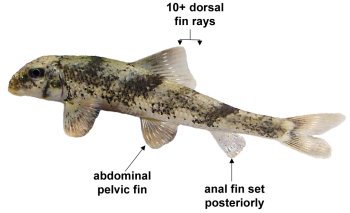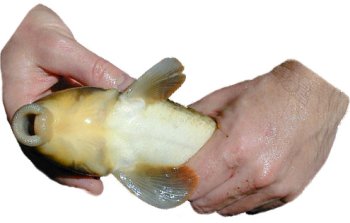Suckers (Catostomidae)
The relatively large family of Catostomidae contains roughly 70 species, the vast majority of which are native to North America. Catostomids can serve as excellent indicators of habitat and water quality as they are primarily benthic or epibenthic in nature, and are often given their own IBI metric in various regional programs. A highly migratory family, small groups are often seen darting up and downstream in streams of good clarity.
Figure 1

Figure 1. Family level identifiers. Northern hog sucker
(Hypentelium nigricans).

Figure 2. Northern hog sucker mouth (Hypentelium nigricans).
Family Level Identifiers (see fig. 1):
- Abdominal pelvic fin.
- Anal fin set posteriorly.
- Dorsal fin with ten or more rays.
- Many species have fleshy, downturned lips (see fig. 2).
- More - tips about genus identification (see below).
- Visit our photo library on suckers.
Habitat:
Suckers are found in a variety of habitats, from glacial lakes to small headwater streams. They are benthic feeders, feeding mainly on macroinvertebrates, organic debris, snails, planktonic algae and small crustaceans.
Pollution Tolerance:
Like most families, pollution tolerance among the catostomids varies from species to species. The white sucker, for example, is known to be tolerant of poor water quality and habitat disturbance, while the black redhorse is a healthy stream indicator. Etnier (1997) noted that imperilment of suckers is most often attributed to stream alterations and nonpoint source pollution.
Use in IBI:
Metrics that directly evaluate the presence and diversity of the sucker family include Metric 4: Number of Sucker Species. When appropriate, pollution intolerant suckers would be used in Metric 5: Number of Intolerant Species. Due to the pollution tolerance of the white sucker, this species is sometimes used as an alternative to Metric 6: Percent Green Sunfish. On a generic level, they would also be used in a few other metrics, such as Metric 1: Total Number of Species.
| Species Name | Common Name | Pollution Tolerance | Habitat Disturbance |
|---|---|---|---|
| Carpiodes carpio | River Carpsucker | M | T |
| Carpiodes cyprinus | Quillback | M | MT |
| Carpiodes velifer | Highfin Carpsucker | I | MT |
| Catostomus catostomus | Longnose Sucker | M | NR |
| Catostomus commersoni | White Sucker | T | I |
| Catostomus macrocheilus | Largescale Sucker | T | NR |
| Cycleptus elongatus | Blue Sucker | I | I |
| Erimyzon oblongus | Creek Chubsucker | M | I |
| Hypentelium nigricans | Northern Hog Sucker | I | I |
| Ictiobus bubalus | Smallmouth Buffalo | M | MT |
| Ictiobus cypinellus | Largemouth Buffalo | M | MT |
| Lagochila lacera | Hairlip Sucker | I | NR |
| Minytrema melanops | Spotted Sucker | M | I |
| Moxostoma anisurum | Silver Redhorse | M | NR |
| Moxostoma carinatum | River Redhorse | I | MI |
| Moxostoma duquesnei | Black Redhorse | I | MI |
| Moxostoma erythrurum | Golden Redhorse | M | MI |
| Moxostoma macrolepidotum | Shorthead Redhorse | M | I |
| Moxostoma valenciennesi | Greater Redhorse | I | NR |
| Pollution Tolerance | Habitat Disturbance |
|---|---|
| T = Tolerant | T = Tolerant |
| M = Intermediate | MT = Moderately Tolerant |
| I = Intolerant | MI = Moderately Intolerant |
| NR = No ranking | I = Intolerant |
| NR = No ranking |
Genus Level Identifiers:
General things to look for:
- Dorsal fin shape and number of rays.
- Texture and structure of lips.
- Body depth to length.
- Scale size and spacing.
Genus Carpiodes (carpsuckers)- Body deep. Head short and stout. Dorsal fin long, greater than 20 rays.
Genus Catostomus (suckers)- Body elongate. Dorsal fin short, less than 20 rays. Head consistent with overall body shape (i.e. no abrupt change, such as short and stout). Scales crowded and smaller anteriorly, becoming larger posteriorly.
Genus Cycleptus (blue suckers)- Body elongate. Head small and slender. Dorsal fin long, greater than 20 rays.
Genus Erimyzon (chubsuckers)- Body somewhat deep. Lateral line absent. Dorsal fin short, less than 20 rays. Anal fin with 7 rays.
![[logo] US EPA](https://cybercemetery.unt.edu/archive/nbii/20120113022219im_/http://www.epa.gov/epafiles/images/logo_epaseal.gif)